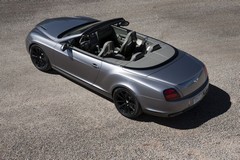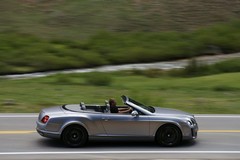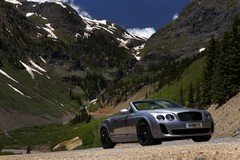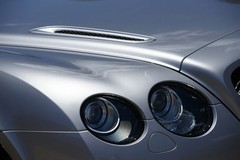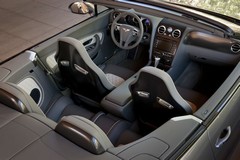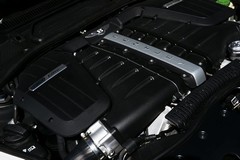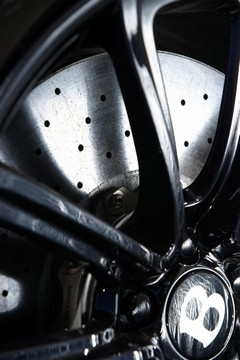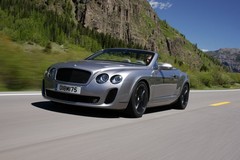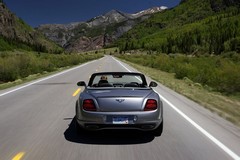Driven: Continental Supersports Convertible
Bentley unleashes the world's fastest four-seater on the world's slowest roads...
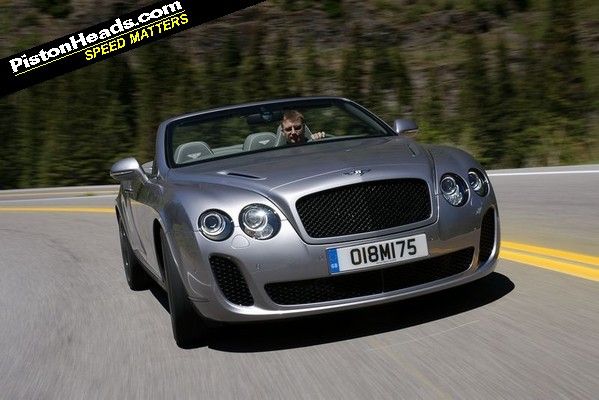
I'd been told that much of the route was speed restricted and heavily enforced, and they weren't kidding. Still, the painfully long, 25mph maximum drive through Telluride Mountain Village's golf course - where golf buggies have priority - gives me an opportunity to enjoy the Supersport's gorgeous interior. Hand-stitched leather and chrome feature everywhere, while matte effect carbon fibre replaces wood, with the black weave covering everything from the dashboard to the seat backs.
Those seats are just lovely, they're manual and account for around 40kg of weight saving over a GTC Speed, but it's the snug fit and fine support that's got me sold. Who needs electric motors anyway? Find a position you like, easy, and stick with it. After all it's not like you're gonna be bunging lots of people the keys to your £178,000 ride. That's a lot of money, even for a Bentley, the Supersports topping the Continental price list and commanding £20,000 more than the already stupidly rapid GTC Speed.
Whether it's worth it isn't really the issue. At this level that jump isn't likely to be of significance to buyers, and could you really walk out of the showroom knowing you'd not ordered the fastest model? For the looks alone I'd struggle, the Supersports Convertible sharing the same more assertive styling of its coupe relative. Arguably they work better with the Convertible, the rear in particular looking fantastic. Thank the wider rear arches, with the flare on the wings covering a 50mm wider track. It's more obvious on the open-topped Superspeed, the flatter deck and lower roof - when it's up - accentuating the rear's additional width.
Up front the deeper vents add assertiveness, the dark metal finish where GTCs usually feature chrome adding to the visual menace. The GT might not be the newest car on the block, but in Supersports Convertible form it's still a serious head turner. And the locals have plenty time to look too, as I'm not going anywhere fast.
On the driveway there's the odd fluffed downshift, the ZF six-speeder evidently needing some heat through it before it's able to deal with the W12's mighty 800Nm (590lb.ft) of torque. It's developed from 2,000-4,500rpm, with peak power of 621bhp arriving at 6,000rpm. It's difficult to keep it at under 25mph, with just the merest tickle of the accelerator or slightest of gradients having it run up to the heady heights of 30mph and beyond.
Salvation lies in an increased limit at the end of the drive, where I can give the Supersports its head up to 50mph. From standstill. Pin the accelerator, wait a tiny moment as the transmission gathers up any slack and the Supersports launches forwards with alarming ease. It's fast, 62mph coming in 4.2 seconds (100mph in 9.6 secs), though I'm on the brakes well before that - my enthusiasm for speed tempered by the promise of ticketing cops and the hand cannons on their belts.
It all means I've plenty time to concentrate on the Bentley's other alterations. The suspension has been pretty comprehensively tweaked, with the wider track joined by stiffer roll bars, a 10mm drop in ride height (over the already dropped GTC Speed), 33% stiffer bushes and re-tuned damper control strategy. Combine that with 20-inch alloy wheels and an open top and you might think it's a recipe for a wobbly, stiff-riding disaster, but the Supersports Convertible rides with a suppleness that's surprising given its focus.
Thank less unsprung weight, with each wheel dropping 2.5kg and the Supersports' standard carbon brakes shifting 20kg overall. Even so, there's the very occasional knock though the suspension and an infinitesimal shimmy from the structure, but it's only apparent when crossing railroad tracks or the massive cracks in the road caused by geological shifts in this mountainous environment.
Did I mention we were high? Ten thousand feet up. The air's thin and it's hot. This might go some way to explaining why the Supersports Convertible doesn't feel as savagely rapid or sound quite as naughty as its coupe did when I drove it recently at sea level.
There's plenty of power, but it doesn't feel like it's got quite the poke to manage its 4.2 second 0-62mph time. Not here, and certainly not today. The engine's a touch less vocal. There's still a sound like someone's tearing the air behind you during foot-to-the-floor acceleration, but there's none of the glorious cackling and popping when you lift off. I'm blaming the environment, as that coupe experienced previously sounded fantastic and accelerated with alarming ferocity. It's still pretty far from but tardy. With switchback bends climbing and descending the beautiful Colorado mountains the Supersports reveals steering with greater feedback. There's not masses of feel, but there's more information at the wheel than any other Conti, and enough to allow you to place the nose with real confidence.
It feels more neutral too, with Bentley shifting the four-wheel drive's bias to the rear - with a 40/60 front/rear split. Revisions to the electronic systems also increases the thresholds of intervention, giving the Supersports' driver more control more of the time. Even in the slower - and that's 10mph signposted - bends there's a greater delicacy to the Supersports's controls. It delivers at speed too, as after too many miles of speedometer watching I forget the cops for a few moments and drive the Supersports how it should be.
Do so and it's crushingly competent. The turn in is sharp and the body remains flat as it sweeps round corners with impunity. The ZF 'box with heat through it and operated by the paddles shifts quickly and cleanly, the engine delivers its massive performance anytime and at any revs, while the massive brakes stop it effectively - though need a firm push to do so. There's real driver appeal here, the Supersports revealing talent that the Continental range has previously hidden under its layers of luxury.
It feels more youthful than any Continental before it, with only the clunky sat nav inside betraying its advancing years. Word is that a new Continental is coming sometime next year, too. If the Supersports previews how that might feel, then it's clear Bentley's got back its sporting mojo.
All with a conscience, too. If you care, the Supersports - and all 2011 model Bentleys - is 'green' too. It's able to drink E85 biofuel, assuming you can find a fuel station with it on its forecourt. Really, huge consumption is huge consumption whatever you put in its tank - the combined 17mpg figure unlikely ever to flash up on the trip computer. Unless you're prone to driving it everywhere at 25mph that is...
CONTINENTAL SUPERSPORTS CONVERTIBLE
TECHNICAL SPECIFICATION
ENGINE
Capacity (cc) 5998
Cylinders W12
Aspiration Twin-turbocharged
Installation Front, longitudinal
Construction Alloy heads and block
Bore/Stroke 84.0/90.2 mm
Compression Ratio 9.0 : 1
Fuel E85 & 98 (95) RON
Valve gear Chain-driven DOHC per bank, 4 valves per cylinder,
cam phased inlet and outlet
Maximum Power 630PS/621 bhp/463 kW @ 6000 rev/min
Maximum Torque 800 Nm/590 lb ft @ 2000 to 4500 rev/min
TRANSMISSION
Type Continuous all-wheel drive with 40/60 rear bias
torque split & Torsen centre differential
Gearbox ZF 6-speed 'Quickshift' automatic
Ratios 1st: 4.172
2nd: 2.340
3rd: 1.521
4th: 1.143
5th: 0.867
6th: 0.691
Final Drive: 3.52:1 front / 3.52:1 rear
PERFORMANCE
Maximum Speed 202mph (325km/h)
0-60 mph 3.9 seconds
0-100 mph 9.6 seconds
0-100 km/h 4.2 seconds
0-160 km/h 9.5 seconds
SUSPENSION
Front Four-link double wishbones, anti-roll bar, air springs
Rear Trapezoidal multi-link, anti-roll bar, air springs
Dampers Continuous Damping Control with four adjustable settings
STEERING
Type Rack & pinion, power-assisted, speed-sensitive
Turns lock to lock 2.6
Turning circle 11.4 metres kerb-to-kerb
BRAKES
Front 420 mm diameter carbon/ceramic, vented & cross-drilled
Rear 356 mm diameter carbon/ceramic, vented & cross-drilled
Anti lock Standard with Electronic Stability Programme (ESP)
8.1 and Electronic Brake Force Distribution (EBD)
BODY & CHASSIS
Construction Steel monocoque, 2-door convertible
Length 4804 mm (189.1inches)
Width across mirrors 2194mm (86.4 inches)
Width mirrors folded 1945mm (76.6 inches)
Kerb weight 2395kg (5279lbs)
Height 1388mm (54.6 inches)
Wheelbase 2745mm (108.1 inches)
Front track 1623mm (63.9 inches)
Rear track 1657mm (65.2 inches)
Wheels 20inch x 9.5J 10-spoke Smoked Chrome Alloy
Tyres 275/35x20 Pirelli Ultra High Performance
Fuel tank capacity 90 litres (19.8 gallons/23.8 US gallons)
FUEL CONSUMPTION / EMISSIONS
Urban 11.1 mpg (25.5 litres / 100 km)
Extra Urban 24.3 mpg (11.6 litres / 100 km)
Combined 17.0 mpg (16.7 litres / 100km)
EPA Drive Cycle City Driving TBC
Highway Driving TBC
Carbon dioxide emissions 388g/km
Emission controls EU V and US Lev 11
Gassing Station | General Gassing | Top of Page | What's New | My Stuff


